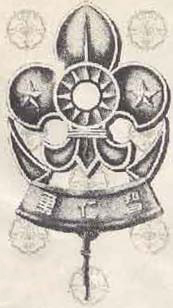Scouts of China
The Scouts of China or the General Association of the Scouts of China in full, is the national Scouting association of the Republic of China and represents the Scouting organization in Taiwan. It is a member of the World Organization of the Scout Movement. In 2011, the Scouts of China has 49,457 members.[1]
| Scouts of China | |||
|---|---|---|---|
 中華民國童軍 | |||
| Headquarters | Hall of the Scouts of China | ||
| Location | Zhongshan District, Taipei | ||
| Country | |||
| Founded |
| ||
| Founder | Yen Chia-lin (嚴家麟) | ||
| Membership | 49,457 (2011) | ||
| Chief Scout | Tsai Ing-wen (蔡英文) | ||
| Chairman | Lin Yu-chang | ||
| Affiliation | World Organization of the Scout Movement | ||
|
| |||
| Website scouting | |||
    | |||
| Scouts of China | |||||||
|---|---|---|---|---|---|---|---|
| Traditional Chinese | 中華民國童軍 | ||||||
| Simplified Chinese | 中华民国童军 | ||||||
| |||||||
| The General Association of the Scouts of China | |||||||
| Traditional Chinese | 中華民國童軍總會 | ||||||
| Simplified Chinese | 中华民国童军总会 | ||||||
| |||||||
History

Mainland China (1912–1949)
Following the birth of the Republic of China, the first Scout troop was organized by Reverend Yen Chia-lin in Wuchang on February 25, 1912 and the Scouting movement spread rapidly all over the country.[2]
The General Association of the Scouts of China was formally established in Nanking, the former capital of the Republic of China in 1934, and became a member of the International Scout Bureau in 1937.[3][4] Many Scouts actively participated in the Second Sino-Japanese War from 1937 to 1945.
There were 570,000 registered members in 1941.[2]
Japanese military authorities did not consistently encourage the Scouting movement in occupied territories. Where local conditions were favorable, authorities would permit local Scouting or introduce Japanese-style Scouting, or Shōnendan, and sometimes even made this compulsory. On the other hand, where conditions were not favorable, and anti-Japanese sentiments were likely to be nurtured through Scouting, the authorities would prohibit it entirely. Taiwan was a colony of the Empire of Japan from 1895 until 1945, and Taiwan Boy Scouts/Shōnendan and other forms of pro-Japanese youth education had been introduced. Conversely, a number of Taiwanese boys were formed into a Shōnendan-style boy corps called Taiwan Shaoniantuan from 1939 through the 1940s to assist in Chinese resistance in the Second Sino-Japanese War.[5]
Scouts of China in Taiwan (1945-)

In 1949, the ROC government withdrew to Taiwan, where it remains today. However, Scouting has continued in Taiwan under the name of the Scouts of China.[2] The organization was reorganized in 1950 after the ROC government was relocated to Taipei, and resumed membership in the International Scout Bureau as Scouts of China.[2][4][6]
Program
.png)
There are 5 programs or sections in the Scouts of China.[7] They are Beaver Scout (稚齡童軍), Cub Scout (幼童軍), Scout (童軍), Senior Scout (行義童軍) and Rover Scout (羅浮童軍).
Beaver Scout is served for the children aged 6 to 8 including 3 ranks: Star (星星), Moon (月亮) and Sun (太陽).
Cub Scout is served for the children aged 8 to 12 including 4 ranks: Anor now, Scouts of China are promoting the development of Sea Scouts.[8]
Scout ideals
Scout Promise
|
我願盡力;愛國家,守規律。
I will do my best to love my country |
憑我的榮譽,我願盡力遵守童軍規律,終身奉行下列三事:
On my honor, I promise that I will do my best to obey and practice the Scout Law and Promise daily.
|
Scout Law
|
服從長上,幫助他人,不說謊話,不怕困難。
Obey elders, |
|
Scout Motto
|
|
Song of the Scouts of China.
中華童軍,童軍,童軍; |
Scouts, Scouts, Scouts of China |
See also
- Scouting in Mainland China
- The Scout Association of Hong Kong
- The Scout Association of Macau
- Girl Scouts of Taiwan
- Sun Li-jen
- Yang Huimin
- World Buddhist Scout Brotherhood
Footnotes
- The original translation for the first paragraph on the official website is "I am willing to become a member of the Scouts of China and therefore I will obey and practice the Scout Law......" according to the pre-2009 version "我願意加入中國童子軍,遵守童子軍規律......." In 2009, the Scout Promise of the Scouts of China was modified, but the translation of the official website is still not corrected.[12]
- The "Blue Sky and White Sun" referred to in the song is the national emblem of the Republic of China and can be found on the national flag.
References
- "Triennal review: Census as at 1 December 2010" (PDF). World Organization of the Scout Movement. Retrieved 2011-01-13.
- "SCOUTING IN CHINA-SCOUTS OF CHINA". N2ZGU. Retrieved 2008-10-24.
- WOSM (1990). Scouting ´Round the World. Geneva: Public Relations and Communications Department, World Scout Bureau. p. 150. ISBN 2-88052-001-0.
- Michel, Rudi; Reinhard Schmoeckel; Hans Gerhard Rumpf (1963). Der Kornett Heft 5 Pfadfinderbewegung (in German). Minden: Bund Deutscher Pfadfinder Landesmark Westfalen. p. 51.
- http://www.scout.org.hk/article_attach/14529/p14.pdf War and Occupation, 1941-1945 by Paul Kua, Deputy Chief Commissioner (Management), Scout Association of Hong Kong, 2010
- WOSM (1990). Scouting ´Round the World. Geneva: Public Relations and Communications Department, World Scout Bureau. p. 27. ISBN 2-88052-001-0.
- "中國童子軍進程合格標準". Scouts of China (in Chinese).
- 蘇芳賜 (2015-08-21). "海童軍體驗聯團活動圓滿閉幕" (in Chinese). Akau News.
- "童軍運動是青少年活動的基石─稚齡童軍與幼童軍". Scouts of China (in Chinese). 2010-08-06.
- "中華民國童軍諾言規律銘言". Scouts of China (in Chinese). 2009-10-14.
- "Promise". Scouts of China. 2009-04-30.
- Chao, Shou-po (2009-11-05). "我們是中華民國童軍──談我國童軍名稱及相關問題~童軍筆記之十八" (in Chinese). Scouts of China.
- "Law". Scouts of China. 2009-04-30.
- "Motto". Scouts of China. 2009-04-30.
- "中国童子军歌" [Chinese Boy Scouts Song] (PDF) (in Chinese). Scouts of China. 2003. Archived from the original (PDF) on 18 December 2003. Retrieved 12 July 2017 – via Wayback machine.
Further reading
- Facts on World Scouting, Boy Scouts International Bureau, Ottawa, Canada, 1961